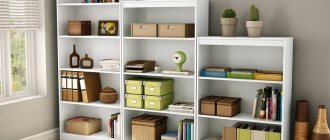Organizing the storage of things is not only a fashion trend, but also a necessity in the modern world. Raising children, working, cooking dinner, or meeting friends at a coffee shop all require a significant amount of time. It is often not enough to organize everyday issues.
No less important is the issue of storing papers and documents. How long will it take to find last year's electricity receipt?
It’s easy to clean up and get rid of unnecessary documents. It is enough to use the recommendations from Marie Kondo, the famous author of space organization techniques.
Content:
- Why save
- Types and terms
- Storage rules
- How to organize document storage at home correctly
- Storage systems for documents at home
- Folders
- Baskets, boxes, boxes
- Briefcase
- Organizer
- Envelopes
- Mini chest of drawers
- Safes
- Electronic
- Paper letters, notices, recipes
- Basic mistakes
- Conclusion
If you leave every piece of paper, then soon you will need a whole room in the apartment just for the archive, which is not always possible. And is it necessary to leave everything? Let's figure out what exactly is worth saving, for how long, and how exactly to do it.
6. Mini chest of drawers
A mini chest of drawers is a very elegant storage solution, and you can decorate it to your liking: all you have to do is buy a wooden blank from Ikea, or ask some friend to make it for you personally.
The drawers in this chest of drawers are very functional and ideal for storing the smallest pieces of paper that are immediately lost forever. Now this will no longer happen! If you like the laconic wooden version of such a chest of drawers, then it will also be very appropriate, especially in minimalist interiors.
Why save
Over the course of a lifetime, a lot of paper documents accumulate. Some can be gotten rid of immediately, since they are short-term in use, but others must be carefully classified, because they may be required at any time for certain purposes:
However, organization is necessary not only to quickly find the paper you need. Some, especially valuable specimens, need to be carefully protected from prying eyes, because their restoration can subsequently turn into a lengthy process. You will have to visit government agencies, sometimes located far from each other, in different regions and settlements, and waste time and your own nerves.
Methods of organization
To quickly find the document you need, you need to divide them into categories. Be sure to attach labels to each category, or use color coding. Paper information can be classified according to its purpose:
- medicine;
- Appliances;
- repair.
Fragmentation that is too fine will result in a clutter of folders that will make it difficult to find the help you need.
Types and terms
You should start exploring ideas and ways to organize document storage at home with classification. Some have an indefinite validity, for example, a birth certificate, while others are limited by a time frame, after which they are disposed of without hesitation so as not to create a mess:
- Tax returns. Everything related to this area is usually saved for no more than 7 years. This is the standard time frame in which they may be required. After this they will never be useful again.
- Receipts. This type is difficult to classify, since some of them need to be left indefinitely, for example, the purchase of a house, car, shares, tickets. Receipts from a regular store are kept for no more than 14–31 days, if there is a possibility (possibility) of returning the purchased product.
- Instructions for equipment. They are needed only to learn how to use an instrument or device, so leaving them for years makes no sense. Moreover, it is easy to find all manuals in electronic form on manufacturers’ websites and on the Internet.
- Warranty cards. They are usually stored until the expiration date (use, use) expires. In the future, it’s just junk that’s better to throw away; it won’t be useful anymore.
- Paid bills. They can concern anything, from utilities to payment for a hotel room. They should be saved for 3 years, after which they lose their validity and are not taken into account by any organizations.
- Contracts, insurance policies, including medical, credit, real estate and car purchases. It is better to make a special separate storage for this category and keep them there indefinitely or for as long as the document is valid.
- Items of personal identification. These include: passports, pension, work and other certificates, certificates (of birth, marriage, divorce, change of surname and name, death), wills. They should never be disposed of and should always be at hand.
How to store instructions for household appliances?
Over the course of his life, a person acquires many different appliances for himself: a curling iron, hair curlers, a hair dryer, a cell phone, a car, he buys appliances for the home: a bread machine, a toaster, a microwave oven, an iron, a sender and other appliances for use. All devices come with instructions for use. Before using the product, you need to read the instructions for its use, know what you can do and what you cannot do, what is the warranty period, return of the product?
Let's consider how and where to store instructions for household appliances.
First of all, you need to start sorting, sorting them into small, medium and large. Instructions for devices that are no longer available can be thrown away.
Shoe box.
We take an ordinary cardboard shoe box. The size of the box depends on how many documents are available. If there are a lot of instructions, then it is best to use a long box from under winter boots.
In order for the box to serve for a long time, it is better to cover it with a bag, wrapping paper or use tape.
Shoe boxes can be used to store instructions
We take the box and insert large instructions, then smaller ones and even smaller ones. We put the box with instructions in a closet or pantry, because the box is large and heavy, it is better to place it on the lower shelves.
Plastic container.
You can store documents in a plastic container. Make colored dividers at the top and indicate devices or make an alphabetical index.
Storing documents in a plastic container
If a person does not throw away the box from under the device, then you can leave the instructions for use inside the box. For example, you can store your sewing machine in a box so that it does not collect dust and leave the instructions there.
Storage rules
To prevent them from losing their neat appearance, it is necessary to comply with certain requirements and procedures:
- The room should be moderately dry (humidity no more than 50–55%).
- It is advisable to ensure a stable temperature within 18–25°C.
- Everything you need is made easily accessible. To make it easy to find on demand.
- They organize everything not only by section, but also by year, which will simplify your search in the future.
Thus, you cannot leave the archive in the attic, where there is an increased fire hazard, in the basement, since the humidity there is often off the charts, or in other similar rooms. Careless attitude leads to premature damage, which is fraught with serious troubles.
How to organize document storage at home correctly
Before preparing your space, we recommend looking for tips from professional designers involved in the design of workspaces and storage. It is enough to simply adapt them to your individual situation, but otherwise they are quite suitable for anyone:
- Everything that is possible should be transferred to electronic form, this will significantly reduce the space allocated for the necessary things.
- What is not needed often, for example, at least once a year, should be put in the farthest corners. This way, more popular media will always be at hand.
- Tools and containers for folding are chosen in different sizes. For example, for small checks and receipts, an A4 organizer is hardly needed. Very small ones can be placed several in one file, sorted by dates and/or other parameters.
- It wouldn’t hurt to create a separate folder for each category of papers. This will greatly simplify the search, especially if you indicate the relevant information on it.
- It is good to choose vertical racks, shelves or boxes, which greatly save space. They are purchased in ordinary furniture stores, and with some dexterity and the ability to use a jigsaw and screwdriver, they are even made independently from MDF, wooden planks or plywood.
At least once a year they conduct a thorough audit of their own archive. This will help you get rid of unnecessary things in time and make the space freer.
Organizer board
An ideal solution for those who spend a lot of time at their desk and are therefore constantly concerned about finding a lost sticker or the right receipt.
The organizing board can be made in a variety of variations, from a frame to which notes are attached with buttons to multifunctional drawers and a magnetic board. It all depends on what is more convenient for you personally.
Storage systems for documents at home
Options are selected after the papers themselves have been completely sorted, classified and arranged into several main piles by topic. For convenience, you can stick a small colored sticker on each, which can be easily removed and will not spoil the surface.
Often, in addition to the personal (for example, for entrepreneurs), there is also a section with office work, which must be set aside. It is recommended to prepare not just separate files for it, but to provide other drawers, cabinets or rooms.
Folders
Each of them must be correctly and clearly signed, conveying information about what is contained in it. The best option is a signature on the spine so that it is immediately clear what is inside. It is convenient to put them in special large boxes of several pieces. Each storage media should be stored separately, classified by type or date. Separately, you will have to organize containers for the following categories:
- Family or personal (domestic and foreign passports, marriage, birth, death, divorce certificates, SNILS, IDs).
- Medicine (contracts with institutions, certificates, extracts, checks, tests, books).
- Purchases (receipts, instructions, warranty cards, etc., which relate to things or devices that are in use at that particular time).
- Studies (certificates, diplomas, permits).
- Utilities (bills, checks paid and not, payments, books).
- Work (recommendations, employment, contracts, certificates from the employment center).
- Credits and borrowings (agreements, receipts, account statements).
- Banking or legal (real estate, cars, yachts, dachas, antiques, apartments, rental agreements, leases, purchase and sale agreements, inheritance agreements, wills, deeds of gift).
Baskets, boxes, boxes
When everything is neatly sorted into classes and sections, it will be much easier to put everything away in specially prepared containers. They can be made of wood, plastic, plywood, cardboard and other suitable materials; it is quite possible to make them with your own hands. The choice of such depends entirely on the owner, as well as on the financial investments that he is willing to allocate for this business.
Briefcase
To store a smaller volume of storage media, a suitcase, diplomat or case with a key is well suited. It is convenient to place folders or files with papers sorted in advance. Different materials are allowed:
- leatherette;
- leather;
- plastic;
- tarpaulin;
- granitol;
- thick fabric.
This method is good because it is very easy to move it when necessary, and also to quickly take it in emergency situations, which cannot be said about the previous ones.
Organizer
There is a colossal number of devices that can be used as an archive. They are made of wood, plastic, plywood, and can be boxes with special cells, large folders with individual files, be in the form of stationary structures that can be disassembled or not, and also have the ability to add additional sections.
There are no criteria for choosing the right one; the main thing is personal convenience. Therefore, everyone can choose something just for themselves, for the interior or in size.
Envelopes
The modern market offers a wide variety of manufacturing materials:
- paper;
- cardboard;
- polyethylene;
- plastic;
- textile;
- fiberglass.
It is quite possible to choose sizes from standard postal to very large, exceeding 1 meter in length. However, these are hardly useful; a standard A4 format is enough to cover all home savings needs.
Mini chest of drawers
Shelves and cabinets are small pieces of furniture that will help you save quite a lot of documentation. They are chosen so that you can simply install boxes on the shelves. Drawers where you can place folders or files are considered convenient.
Furniture of this type can be metal, wood, plywood, MDF, plastic and even polyethylene. Usually the choice concerns not materials, but size, harmony and compliance with the basic interior design.
Safes
A large metal storage box is suitable for those who have a lot of important papers that should be saved for a long time, for example, entrepreneurs for financial reporting. Hiding places can be equipped with modern combination electronic locks, fingerprint scanners, retina scanners and other technological equipment.
Such a device takes up quite a lot of space. But there is an option to choose something small, built into the wall, hidden behind a picture, minibar, or bookshelf.
Electronic
When everything is more or less clear with the classification and containers, all that remains is to sort out ideas and life hacks on how to conveniently and correctly store documents at home in perfect order, and never get confused among them. In the age of technical progress and developed technologies, saving on digital media has come to the fore. All the most important ones can be scanned, and if necessary, even copies can be certified by a notary using an electronic signature. If suddenly they are lost for any reason, this will help to restore them faster.
All information is contained on a flash drive, but ideally it should also be duplicated in cloud storage. This will prevent loss if the media fails. Then the data will remain on the Internet, from where it can be retrieved upon request.
iPhone, iPad and Mac: Apple has already thought of everything for you - as always
Organizing photos on iPhone, iPad and Mac, to the great happiness of their owners, is much easier. All three devices have a universal Photos program, which itself figures out how to sort your photos - and does it completely correctly from a psychological point of view.
Photos on iPhone, iPad, and Mac
To let your Apple devices do the smart sorting for you, keep geolocation and clock turned on on your iPhone, iPad, or camera. Then in the Photo program all your photos will automatically be divided into:
- Moments are groups of photographs taken in a certain place and at approximately the same time.
- Collections are groups of moments that are united by a common place, for example, all the moments of your vacation in Crimea.
- Years - all collections for certain years.
If you have photos taken before GPS was widespread, no problem! You can create smart albums in the same way in Apple's Photos app. Open the Albums tab, click Add and add all the photos to the album for a certain time - for example, for your birthday in 2003 - here you have a new moment.
Apple has a very comfortable and intelligent photo search. The program can search for events, dates and people in photographs using geodata and shooting time, as well as facial recognition. The Photo program has a unique Memories tab, where the program itself compiles a selection of photos for you using intelligent algorithms - just open it and the program will help you remember your son’s wedding or trip to Altai in August 2016.
In short, there is no need to even think about how to organize photos on your iPhone, iPad or Mac. Apple has already thought for you - and, by the way, we consider its decision to be very successful.
Paper letters, notices, recipes
It is more convenient to store current ones as is. It is not at all productive to transfer them into electronic format, because they must always be at hand. Current securities sent by mail should be immediately classified: irrelevant ones are thrown away, and necessary ones are kept in a special box, suitcase, organizer or chest of drawers for several days, months or even years:
- Subpoenas, extracts or other information are left for at least 1 year. It makes sense to put them together with bank notices.
- It is advisable to save responses from various authorities to requests for 3 years. You can create a folder under them.
- Recipes are left on paper. They are stored not only in a separate file, but also in another basket. It’s practical to keep them right in the kitchen so that you can quickly find any cooking instructions at any time.
Receipts and receipts from the store are temporarily dumped into one basket. It is best to sort everything from such storage once a week before it accumulates too much. Some will go to waste, and the other will be placed in certain files.
Paper holder
The paper holder is useful for storing memorable paper items, as well as for pieces of paper with the necessary phone numbers or hint notes.
The holder can be made in both a laconic and intricate style, so it will become an excellent decorative element for the room.
Basic mistakes
In such a simple matter, many make typical mistakes, which can then seriously interfere with the search:
- There are many household members involved in work. When one person is busy with something, he knows exactly what is and where it is, and can intuitively understand the harmonious system he has created. Therefore, it is better not to have everyone sorting and classifying, but to choose someone responsible and delegate all the powers to them.
- Little time to organize. It is important to plan the process correctly in order to do everything thoughtfully and methodically, without rushing.
- Incorrect compilation of subsections, discrepancy between deadlines and dates. Subsequently, it is difficult to find what you need. Methodical, regular neglect of these factors leads to disorder.
Often in the process, many people become confused about some papers that are unclear where to put them. They just hide them and then can't remember where. For this type of storage media, it is worth having a separate place that will have to be sorted out regularly.
Principle 10. Don't forget about the value of things!
It seems to be a completely understandable truth, but, alas, many people forget about it, and then cry bitterly over their grandmother’s broken vase, damaged photographs or family heirlooms. Any items (boxes, containers, dishes) on the shelves should be placed stably, clothes made of delicate fabrics should be stored in special cases, valuable papers and photographs should be kept away from moisture, sunlight and aggressive substances. Things dear to the heart should be kept away from everyday items that are not of particular value, but can violate the storage conditions of family heirlooms or expensive items.











